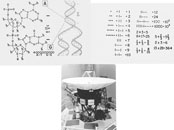![]()
| Nature 431, 27 - 28 (02 September 2004); doi:10.1038/431027a |
|
WOODRUFF T. SULLIVAN III
Extraterrestrial civilizations may find it more efficient to communicate by sending material objects across interstellar distances rather than beams of electromagnetic radiation.
Are we alone? Although the Search for Extraterrestrial Intelligence (SETI) has yet to detect a signal, the efforts continue because so little of the possible parameter space has been searched so far. These projects have almost all followed the dominant paradigm — launched 45 years ago by Cocconi and Morrison in the pages of this journal1 — of using radio telescopes to look for signs of extraterrestrial life. This focus on electromagnetic waves (primarily at radio wavelengths, but also at optical ones) was based on various arguments for their efficiency as a means of interstellar communication. On page 47 of this issue, however, Rose and Wright2 make the case that, if speedy delivery is not required, long messages are in fact more efficiently sent in the form of material objects — effectively messages in a bottle. Although the suggestion itself is not new3, 4, it had never before been backed up by quantitative analysis.
A fundamental problem in searching for extraterrestrial intelligence is to guess the communications set-up of the extraterrestrials who might be trying to contact us. In which direction should we look for their transmitter? At which frequencies? How might the message be coded? How often is it broadcast? (For this discussion I am assuming that the signals are intentional, setting aside the a priori equally likely possibility that the first signal found could be merely leakage arising from their normal activities.) Conventional wisdom holds that they would set up a beam of electromagnetic waves, just as we could do with, for example, the 305-metre Arecibo radio telescope in Puerto Rico, Earth's most powerful radio transmitter, or a pulsed laser on the 10-metre Keck optical telescope in Hawaii. Rose and Wright conclude, however, that the better choice would be to send packages laced with information.
Unless the messages are short or the extraterrestrials are nearby, this 'write' strategy requires less energy per bit of transmitted information than the 'radiate' strategy does. Cone-shaped beams of radiation necessarily grow in size as they travel outwards, meaning that the great majority of the energy is wasted, even if some of it hits the intended target. A package, on the other hand, is not 'diluted' as it travels across space (Fig. 1), presuming that it's correctly aimed at its desired destination. For short messages, however, electromagnetic waves win out because of the overheads involved in launching, shielding and then decelerating a package, no matter how small it is — FedEx charges you just as much to send a microgram as 100 grams. For a two-way conversation with extraterrestrials, the light-speed of electromagnetic waves is far superior.
 |
Figure 1
Is there anybody out there?
Full legend High resolution image and legend (37k) |
As an example of a large message, consider all of the written and electronic information now existing on Earth: it's estimated5 to amount to about one exabyte (that's 1018 bytes, or 1019 bits). Rose and Wright calculate that, using scanning tunnelling microscopy, these bits could be inscribed (in nanometre squares) within one gram of material! But this precious package would still require a cocoon of 10,000 kilograms to accelerate it from our planet to a speed of 0.1% of the speed of light, protect it from radiation damage along a 10,000-light-year route, and then decelerate it upon arrival.
Rose and Wright's arguments are open to various criticisms. We do not understand how economics works on this planet, let alone for an extraterrestrial intelligence, so it is not clear that the key criterion in choosing a message's medium would be energy expended per bit, as these authors assume. Furthermore, we do not know if such packages, even if efficiently sent, would ever in fact be recognized and opened. Of course, we also do not know whether electromagnetic signals intended for us — and which may in fact be now bathing the Earth — will ever be recognized as such. In both cases, repetition and diversity of communications media would seem to increase the extraterrestrials' and our chances of success.
So how should these results influence today's SETI strategy? Short "we are here" messages would still seem to be most efficiently sent by electromagnetic waves, and we should continue looking for the same. But perhaps some attention should be paid to the possibility of one day finding in our Solar System an information-drenched artefact, sent by an extremely advanced extraterrestrial civilization interested only in one-way communication. This intruder might be orbiting the Sun or a planet, or resting somewhere on a planet, moon or asteroid. The scenario is reminiscent of Arthur C. Clarke's 2001: A Space Odyssey, in which a monolith discovered on the Moon has been left by extraterrestrials. If astroarchaeologists were to find such an object, it would hardly be the first time that science fiction had become science fact.
| 1. | Cocconi, G. & Morrison, P. Nature 184, 844–846 (1959). | ISI | |
| 2. | Rose, C. & Wright, G. Nature 431, 47–49 (2004). | Article | |
| 3. | Bracewell, R. Nature 187, 670–671 (1960). |
| 4. | Papagiannis, M. Q. J. R. Astron. Soc. 19, 277–281 (1978). | ISI | |
| 5. | Murphy, C. Atlantic 277, No. 5, 20–22 (1996). |